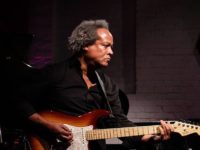Sometimes, you dial up a particular piece of music because you know what you’re getting. You’re in a certain mood, and the Nth listen to The Ramones’ Rocket To Russia is what you need. There’s nothing wrong with that because there are an infinite number of reasons why we listen. The ear parts want what the ear parts want.
What’s not so straightforward is the origin of the desire. Sometimes, as in the previous paragraph, we might be particularly happy and want to enhance that feeling. The connection between down moods and melancholy listening can be just as direct. But what about music that is not so obvious? Music that defies easy categorization? Music that doesn’t freely give a read on its emotional content? While it might not be possible to come up with a universal truth on this matter, Tyshawn Sorey’s Koan is a perfect recording to wrap the discussion around.
This set of fully improvised compositions (an oxymoron of sorts, since Sorey did provide some melodic direction as ‘seed’ material) intrigues the ear with slowly developing structures and surprising changes in direction. The lineup of Sorey on drums, Todd Neufeld (guitar), and Thomas Morgan (guitar and bass) manages to create uncluttered sound poems that avoid the usual jazz melody vs. rhythm roles.
“Awakening” provides a great example of this trio’s somewhat unorthodox approach. A short cymbal wash introduces a pair of chords placed a short distance apart. The guitar mines this interval repeatedly, setting up a very minimalistic ostinatto of sorts. Neufeld occasionally explores other sound fragments but always returns. After several minutes have passed, the drums and bass enter to encircle a single chord with a series of rhythmic patterns. The intensity slowly builds to a peak and with four minutes to go, we return to that pensive set of two chords. It is from here on that Morgan’s bass takes over. Guitar and drums fall away, revealing fragments that at first continue to imply the simple harmonic structure before going off to investigate related melodic paths. This is exactly the kind of music I think of when a composition is described as “telling a story.”
You will notice that I didn’t say a whole lot about Sorey’s drumming in that first piece. It is to his credit that this record does not become another “drummer’s album.” The music is allowed to breathe without fear of being washed out by excessive kit work.
For a more ‘normal’ (read: jazz-like) selection, give “Correct Truth” a listen. Its spiky angularity reminds me of something Ornette Coleman or Jimmy Giuffre might have done — knotty little clusters of sound are given space to ring out to infinity before the band lurches off in a different direction. There’s some high-level listening going on here. Great stuff.
Still, this group absolutely shines in the longer-form improvisations. “Embed” closes out Koan with yet another story told with sensitivity and elan. Rhythmically switching between pure rubatto and near-swing (they don’t get there, mostly because that probably wasn’t the intent), there’s a feeling of discovery the gives a subtle sense of rising energy.
I’m not sure what kind of mood would induce the next listen to Koan. Maybe that’s its greatest charm.
[amazon_enhanced asin=”B0039GF5WK” container=”” container_class=”” price=”All” background_color=”FFFFFF” link_color=”000000″ text_color=”0000FF” /] [amazon_enhanced asin=”B005DKGNH6″ container=”” container_class=”” price=”All” background_color=”FFFFFF” link_color=”000000″ text_color=”0000FF” /] [amazon_enhanced asin=”B000YDL2DC” container=”” container_class=”” price=”All” background_color=”FFFFFF” link_color=”000000″ text_color=”0000FF” /] [amazon_enhanced asin=”B003N03JLG” container=”” container_class=”” price=”All” background_color=”FFFFFF” link_color=”000000″ text_color=”0000FF” /] [amazon_enhanced asin=”B004SQAF70″ container=”” container_class=”” price=”All” background_color=”FFFFFF” link_color=”000000″ text_color=”0000FF” /]
- How Eric Clapton’s ‘Me and Mr. Johnson’ Made the Case for British Blues - March 20, 2024
- Why Todd Rundgren’s ‘Back to the Bars’ Remains So Powerful - December 13, 2023
- Reevaluating Bruce Springsteen’s ‘The Wild, the Innocent and the E Street Shuffle’ - September 11, 2023




